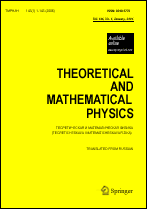|
This article is cited in 82 scientific papers (total in 82 papers)
Analytic Perturbation Theory for QCD Observables
D. V. Shirkov
Joint Institute for Nuclear Research, Bogoliubov Laboratory of Theoretical Physics
Abstract:
We investigate the connection between ghost-free formulations of the RG-invariant QCD perturbation theory in the spacelike and timelike regions. Our basic tool is the “double spectral representation”, similar to the representation for the Adler function, which stems from the first principles of local QFT and relates real functions in the Euclidean and Minkowskian (i.e., timelike) regions. On this base, we establish a simple relation between the approach (known from the early 1980s) of resumming the $\pi^2$ terms for the invariant coupling function $\tilde\alpha(s)$ and QCD observables in the timelike region and the invariant analytic approach (devised a few years ago) leading to the “analyticized” coupling function $\alpha_{\text{an}}(Q^2)$ and nonpower expansion for observables in the spacelike domain. The function $\alpha_{\text{an}}(Q^2)$ and the expansion are free of unphysical singularities. The formulated self-consistent scheme, analytic perturbation theory (APT), relates renorm-invariant, effective coupling functions $\alpha_{\text{an}}(Q^2)$ and $\tilde\alpha(s)$, as well as nonpower perturbation expansions for observables in the Euclidean and Minkowskian domains, free of extra singularities and with better convergence in the infrared region. We present a global generalization of the new APT scheme in the case of real QCD, including the domain with various numbers of active quarks. Preliminary estimates indicate that calculations in the framework of the global scheme can produce results quite different from the usual ones for $\bar\alpha_{s}$ , even in the five-quark region. Numerical examples are given.
Received: 22.11.2000
Citation:
D. V. Shirkov, “Analytic Perturbation Theory for QCD Observables”, TMF, 127:1 (2001), 3–20; Theoret. and Math. Phys., 127:1 (2001), 409–423
Linking options:
https://www.mathnet.ru/eng/tmf445https://doi.org/10.4213/tmf445 https://www.mathnet.ru/eng/tmf/v127/i1/p3
|


|




 Contact us:
Contact us: Terms of Use
Terms of Use
 Registration to the website
Registration to the website Logotypes
Logotypes







 Citation in format
Citation in format 
